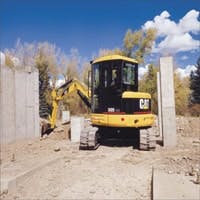Long popular in Japan and Europe where work often is done in tight spaces, mini-excavators have become a force in this country as American manufacturers have developed their own mini-excavators to compete with popular imports. And a large number of mini-excavators on U.S. jobsites today are rented.
Most general rental centers have at least a couple of these smooth-operating compacts. Equipment-rental specialists have mini-excavator fleets with models in several sizes to meet the needs of customers doing a variety of construction, maintenance, landscaping, and demolition projects.
Ready Rent-All in Decatur, Ga., was one of the first rental stores in the Atlanta area to offer a mini-excavator, adding them to the mix in the early '80s, says company owner Jeffery Wearing. "It was compact for working in small places, easy to haul, and customers liked it immediately," he says.
Wearing soon added a second machine, and today his firm has a dozen units regularly rented by a broad range of customers. "Demand is very strong," he says.
Cat Rental Stores saw similar interest after the manufacturer added compact excavators to its line of equipment in 1999. "Demand for the product grew more than 60 percent from 1999 through 2002," says Dan Bruch, Caterpillar sales manager for mini hydraulic excavators and compact wheel loaders. "Mini-excavators can work in places where larger backhoes and excavators can't go."
Anthony Gonnella, vice president of sales for Hertz Equipment Rental Corp. (HERC), says customers like mini-excavators with zero tail swing because they can work close to buildings, and because lightweight models are good for working on soft ground.
"Plumbing contractors use the equipment for digging trenches for piping; landscapers use mini-excavators for jobs such as tree planting," he says. "Attachments provide versatility for many other projects."
Size is one obvious reason for the popularity of mini-excavators. Small footprints allow the machines to work in backyards, narrow easements, inside buildings, and other areas where larger equipment can't go. Mini-excavators speed completion of many jobs by doing work that otherwise would require hand labor. Their size and light weight mean equipment can be transported by trucks that don't require drivers with commercial drivers' licenses.
But size isn't the only reason users like mini-excavators. The ability to dig offset trenches sets them apart from backhoe-loaders and other excavation equipment. This is made possible by two features: a rotating cab and independent left-right boom swing, which enables the operator to offset the boom to dig adjacent to foundations, fences and other obstacles.
Zero tail swing is available on many models. With no part of the tail extending outside the width or length of the machine's tracks, cabs can rotate a full 360 degrees, even in areas where there are obstructions. Full-circle cab swing permits digging in any area around the machine and depositing spoils wherever necessary within the boom's reach without repositioning the machine.
Smooth-operating hydraulics and fast cycle times permit mini-excavators to dig and move large volumes of dirt quickly. Most models are equipped with a dozer blade which serves as a stabilizer while excavating and permits the machine to do grading and move debris. High-flotation rubber tracks permit compact units to travel across and operate on paving, lawns and other improved surfaces, as well as in muddy conditions. Mini-excavators come in a variety of sizes, defined by weight.
Gonnella says HERC stores inventory machines ranging from 1 to 8 metric tons with the most popular models being in the 3- to 4-metric-ton sizes. Cat stores, says Bruch, carry units in 1- to 5-metric-ton classifications with 3- to 5-metric-ton models rented most often. Models and attachments at stores in both organizations are influenced by customer demands.
Finally, with the availability of a broad selection of attachments, mini-excavators are multi-purpose tool carriers. "Attachments extend the versatility of mini-excavators," says Bruch. "For instance, in utility work, a hydraulic hammer could be used to break a concrete pad. Then, a thumb and bucket could be used to pick up the debris. A variety of buckets sizes are available to dig the hole. While filling in the hole, a vibratory or roller compactor could be used. Quick-coupler connections reduce time needed to switch attachments."




